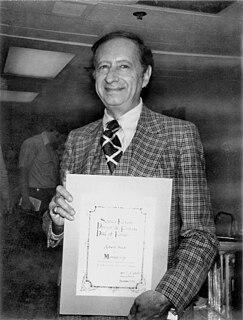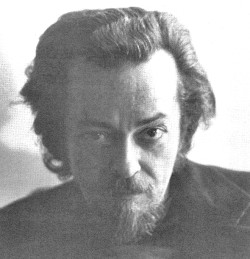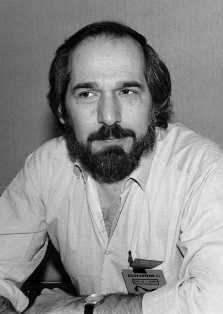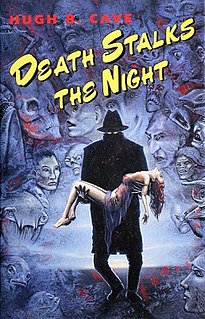
Horror is a genre of speculative fiction which is intended to frighten, scare, or disgust. Literary historian J. A. Cuddon defined the horror story as "a piece of fiction in prose of variable length... which shocks, or even frightens the reader, or perhaps induces a feeling of repulsion or loathing". Horror intends to create an eerie and frightening atmosphere for the reader. Horror is often divided into the psychological horror and supernatural horror sub-genres. Often the central menace of a work of horror fiction can be interpreted as a metaphor for larger fears of a society. Prevalent elements include ghosts, demons, vampires, werewolves, ghouls, the Devil, witches, monsters, extraterrestrials, dystopian and post-apocalyptic worlds, serial killers, cannibalism, psychopaths, cults, dark magic, satanism, the macabre, gore and torture.

Robert Albert Bloch was an American fiction writer, primarily of crime, psychological horror and fantasy, much of which has been dramatised for radio, cinema and television. He also wrote a relatively small amount of science fiction. His writing career lasted 60 years, including more than 30 years in television and film. Best known as the writer of Psycho (1959), the basis for the film of the same name by Alfred Hitchcock, Bloch wrote hundreds of short stories and over 30 novels. He was a protégé of H. P. Lovecraft, who was the first to seriously encourage his talent, and began his professional writing career immediately after graduation, aged 17. However, while Bloch started his career by emulating Lovecraft and his brand of "cosmic horror", he later specialized in crime and horror stories dealing with a more psychological approach.

Weird Tales is an American fantasy and horror fiction pulp magazine founded by J. C. Henneberger and J. M. Lansinger in late 1922. The first issue, dated March 1923, appeared on newsstands February 18. The first editor, Edwin Baird, printed early work by H. P. Lovecraft, Seabury Quinn, and Clark Ashton Smith, all of whom went on to be popular writers, but within a year, the magazine was in financial trouble. Henneberger sold his interest in the publisher, Rural Publishing Corporation, to Lansinger, and refinanced Weird Tales, with Farnsworth Wright as the new editor. The first issue under Wright's control was dated November 1924. The magazine was more successful under Wright, and despite occasional financial setbacks, it prospered over the next 15 years. Under Wright's control, the magazine lived up to its subtitle, "The Unique Magazine", and published a wide range of unusual fiction.

Linwood Vrooman Carter was an American author of science fiction and fantasy, as well as an editor, poet and critic. He usually wrote as Lin Carter; known pseudonyms include H. P. Lowcraft and Grail Undwin. He is best known for his work in the 1970s as editor of the Ballantine Adult Fantasy series, which introduced readers to many overlooked classics of the fantasy genre.

Hugh Barnett Cave was an American writer of various genres, perhaps best remembered for his works of horror, weird menace and science fiction. Cave was one of the most prolific contributors to pulp magazines of the 1920s and '30s, selling an estimated 800 stories not only in the aforementioned genres but also in western, fantasy, adventure, crime, romance and non-fiction. He used a variety of pen names, notably Justin Case under which name he created the antihero The Eel. A war correspondent during World War II, Cave afterwards settled in Jamaica where he owned and managed a coffee plantation and continued his writing career, now specializing in novels as well as fiction and non-fiction sales to mainstream magazines.

Unknown was an American pulp fantasy fiction magazine, published from 1939 to 1943 by Street & Smith, and edited by John W. Campbell. Unknown was a companion to Street & Smith's science fiction pulp, Astounding Science Fiction, which was also edited by Campbell at the time; many authors and illustrators contributed to both magazines. The leading fantasy magazine in the 1930s was Weird Tales, which focused on shock and horror. Campbell wanted to publish a fantasy magazine with more finesse and humor than Weird Tales, and put his plans into action when Eric Frank Russell sent him the manuscript of his novel Sinister Barrier, about aliens who own the human race. Unknown's first issue appeared in March 1939; in addition to Sinister Barrier, it included H. L. Gold's "Trouble With Water", a humorous fantasy about a New Yorker who meets a water gnome. Gold's story was the first of many in Unknown to combine commonplace reality with the fantastic.

Charles Lewis Grant was an American novelist and short story writer specializing in what he called "dark fantasy" and "quiet horror". He also wrote under the pseudonyms of Geoffrey Marsh, Lionel Fenn, Simon Lake, Felicia Andrews, and Deborah Lewis.
Ray Russell was an American editor and writer of short stories, novels, and screenplays. Russell is best known for his horror fiction, although he also wrote mystery and science fiction stories.
Robert Edward Weinberg was an American author, editor, publisher, and collector of science fiction. His work spans several genres including non-fiction, science fiction, horror, and comic books.

Henry Slesar was an American author, playwright, and copywriter. He is famous for his use of irony and twist endings. After reading Slesar's "M Is for the Many" in Ellery Queen's Mystery Magazine, Alfred Hitchcock bought it for adaptation and they began many successful collaborations. Slesar wrote hundreds of scripts for television series and soap operas, leading TV Guide to call him "the writer with the largest audience in America."
Michael Raymond Donald Ashley is a British bibliographer, author and editor of science fiction, mystery, and fantasy.

Death Stalks the Night is a collection of fantasy and horror and Mystery short stories by author Hugh B. Cave. It was originally to have been the fifth volume published by Carcosa, the North Carolina joint publishing venture founded by Karl Edward Wagner, Jim Groce and David Drake. However, Lee Brown Coye, who was completing the illustrations for the volume, died, stalling its publication by Carcosa.

Before…12:01…and After is a collection of science fiction, fantasy, mystery and horror stories by author Richard A. Lupoff. It was released in 1996 by Fedogan & Bremer in an edition of 2,100 copies of which 100 were signed by the author and the artist. Many of the stories originally appeared in the magazines Pagoda, Fantasy and Science Fiction, Heavy Metal, Fantastic, Whispers, Isaac Asimov's Science Fiction Magazine, Detective Story Magazine, Hardboiled and Ellery Queen's Mystery Magazine.

Exorcisms and Ecstasies is a collection of fantasy and horror short stories by author Karl Edward Wagner. The collection also includes a number of memoirs and articles about Wagner and is edited by Stephen Jones. It was released in 1997 by Fedogan & Bremer in an edition of 2,100 copies, of which 100 included Wagner's signature taken from a canceled check or contract. The limited edition was also signed by the artist, editor and other contributors to the collection. Many of the stories originally appeared in a number of different anthologies and collections or in the magazines Beyond Fantasy & Science Fiction, Kadath, Weird Tales, The Centralite, Midnight Sun, Fantasy Crossroads and Gauntlet.

A Coven of Vampires is a collection of horror short stories by English writer Brian Lumley. The stories all concern vampires. It was released in 1998 by Fedogan & Bremer in an edition of 1,100 copies, of which 100 were numbered and signed by the author, and illustrator. Most of the stories originally appeared in a number of different anthologies and collections or in the magazines Terror Australis, Fantasy Tales, Weirdbook, Fear!, Fantasy and Science Fiction and Kadath.

Far Lands, Other Days is a collection of fantasy, horror and mystery short stories by author E. Hoffmann Price. It was released in 1975 by Carcosa in an edition of 2,593 copies of which 615 copies, that were pre-ordered, were signed by the author and artist. The stories originally appeared in the magazines Weird Tales, Strange Detective Stories, Spicy-Adventure Stories, Golden Fleece, Argosy, Spicy Mystery Stories, Strange Stories, Short Stories, Terror Tales and Speed Mystery.

Murgunstrumm and Others is a collection of horror short stories by author Hugh B. Cave. It was released in 1977 by Carcosa in an edition of 2,578 copies of which the 597 copies, that were pre-ordered, were signed by the author and artist. Many of the stories originally appeared in the magazines Strange Tales of Mystery and Terror, Weird Tales, Spicy Mystery Stories, Ghost Stories, Thrilling Mysteries, Black Book Detective Magazine, Argosy, Adventure, Ellery Queen's Mystery Magazine and Whispers. It has since been reissued by Wildside Press in trade paperback and hardcover.

Horror comics are comic books, graphic novels, black-and-white comics magazines, and manga e.g. focusing on horror fiction. In the US market, horror comic books reached a peak in the late 1940s through the mid-1950s, when concern over content and the imposition of the self-censorship Comics Code Authority contributed to the demise of many titles and the toning down of others. Black-and-white horror-comics magazines, which did not fall under the Code, flourished from the mid-1960s through the early 1980s from a variety of publishers. Mainstream American color comic books experienced a horror resurgence in the 1970s, following a loosening of the Code. While the genre has had greater and lesser periods of popularity, it occupies a firm niche in comics as of the 2010s.

Strange Tales was an American pulp magazine first published from 1931 to 1933 by Clayton Publications. It specialized in fantasy and weird fiction, and was a significant competitor to Weird Tales, the leading magazine in the field. Its published stories include "Wolves of Darkness" by Jack Williamson, as well as work by Robert E. Howard and Clark Ashton Smith. The magazine ceased publication when Clayton entered bankruptcy. It was temporarily revived by Wildside Press, which published three issues edited by Robert M. Price from 2003 to 2007.

Science-fiction and fantasy magazines began to be published in the United States in the 1920s. Stories with science-fiction themes had been appearing for decades in pulp magazines such as Argosy, but there were no magazines that specialized in a single genre until 1915, when Street & Smith, one of the major pulp publishers, brought out Detective Story Magazine. The first magazine to focus solely on fantasy and horror was Weird Tales, which was launched in 1923, and established itself as the leading weird fiction magazine over the next two decades; writers such as H.P. Lovecraft, Clark Ashton Smith and Robert E. Howard became regular contributors. In 1926 Weird Tales was joined by Amazing Stories, published by Hugo Gernsback; Amazing printed only science fiction, and no fantasy. Gernsback included a letter column in Amazing Stories, and this led to the creation of organized science-fiction fandom, as fans contacted each other using the addresses published with the letters. Gernsback wanted the fiction he printed to be scientifically accurate, and educational, as well as entertaining, but found it difficult to obtain stories that met his goals; he printed "The Moon Pool" by Abraham Merritt in 1927, despite it being completely unscientific. Gernsback lost control of Amazing Stories in 1929, but quickly started several new magazines. Wonder Stories, one of Gernsback's titles, was edited by David Lasser, who worked to improve the quality of the fiction he received. Another early competitor was Astounding Stories of Super-Science, which appeared in 1930, edited by Harry Bates, but Bates printed only the most basic adventure stories with minimal scientific content, and little of the material from his era is now remembered.

















